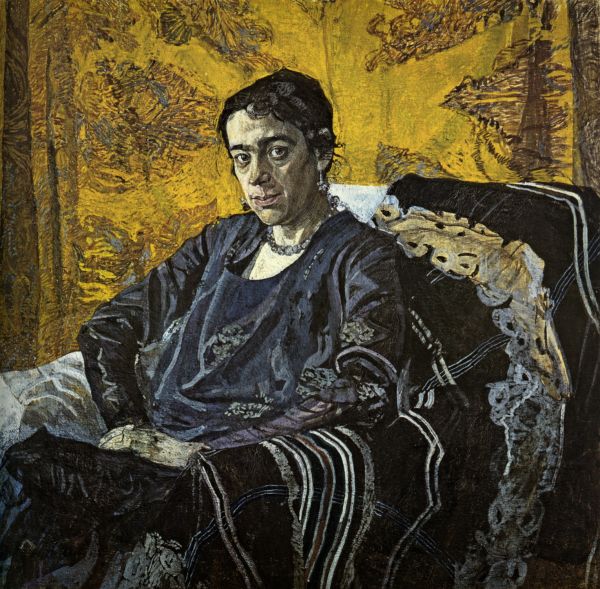|
|
Portrait of Nadezhda Dobychina. 1920

Golovin Alexander,
Oil on canvas
97,4 х 99,5
State Russian Museum
Пост. в 1937 от А. Я. Головиной, вдовы художника, Ленинград
Annotation
Nadezhda Yevseyevna Dobychina (née Fishman) (1884–1950). Mistress of an art salon called the Nadezhda Dobychina Bureau d’Art on Divenskaya Street, 63 Moika and 7 Field of Mars in Petrograd (1911–20), headed the Society of Chamber Music (1922–33). Curator and head of the department of Soviet art at the Russian Museum (1932–34). Curator of the Museum of the Revolution.
Nadezhda Dobychina poured all her energy, will and character into the organisation of a bureau d’art, where she held a series of exhibition and concerts. Among the most exciting events were Natalia Goncharova’s one-woman show (1913), 0.10. Last Futurist Exhibition (1915) and an exhibition of Finnish art (1917). These shows made an important contribution to Petrograd art life. Over the seven years it was open, Nadezhda Dobychina’s bureau won great authority in the Russian art world; some three hundred artists contributed to its exhibitions. Nadezhda’s business was loudly praised by her contemporaries. Alexander Benois noted: “At long last, we too have a European-style art shop”. The newspapers wrote: “The art bureau is run respectably and conscientiously. In only one year, it has attracted many talented and serious artists ... Nadezhda Dobychina’s art bureau on the Field of Mars is a concentration of Petrograd art life. All that is fresh and interesting this current season has invariably found refuge in Dobychina’s modest halls.”
Nadezhda Dobychina’s portrait was painted by many artists – Nathan Altman (1913), Konstantin Somov (1920), Pyotr Neradovsky (1922) and Alexander Benois in Paris (1925). Alexander Golovin’s image is typical of his mature period – decorative pageantry intensified by an abundance of fabrics, a balanced composition inserted into a square and merciless realism in the depiction of the sitter’s outer appearance. The artist masterly conveys all the complexities and contradictions of Nadezhda Dobychina’s character – an energetic and decisive will intertwined with suppressed disquiet and suffering. More grotesque than beautiful, the sharp chiaroscuro modelling and angular brittle lines on her face and the heavy glance directed at the viewer add drama and tension to this vivid image.
Author's Biography
Golovin Alexander
Golovin, Alexander Yakovlevich
1863, Moscow - 1930, Detskoe Selo (Leningrad Region)
Theatrical designer, painter, graphic artist. Studied under Illarion Pryanishnikov and Vasily Polcnov at the Moscow School of Painting, Sculpture and Architecture (1881-89) and at the Academic de Filippo Colarossi (1889) and Academie Witti (1897) in Paris. Academician (1912). Member of the World of Art (1902) and the Union of Russian Artists (1903). Contributed to the exhibitions of the Society of Travelling Art Exhibitions (1893, 1895), Moscow Fellowship of Artists (1894, 1901-02), World of Art (1899-1903, 1906, 1911-12, 1924), Union of Russian Artists (1903-09, 1916), New Society of Artists (1907, 1908), Expositions Universelles in Paris (1900; gold and silver medals) and Brussels (1910), Esposizione Internazionale in Venice (1907) and Rome (1911) and the Exhibitions of Russian Art in Paris (1906) and Berlin (1906). Designed for the Bolshoi Theatre and Moscow Arts Theatre in Moscow, Mariinsky and Alexandrinsky Theatres in Si Petersburg and Sergei Diaghilev''s Saisons Russes (1908,1910).

